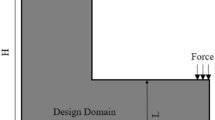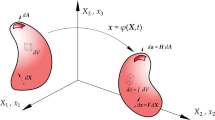Abstract
This paper deals with topology optimization of static geometrically nonlinear structures experiencing snap-through behaviour. Different compliance and buckling criterion functions are studied and applied for topology optimization of a point loaded curved beam problem with the aim of maximizing the snap-through buckling load. The response of the optimized structures obtained using the considered objective functions are evaluated and compared. Due to the intrinsic nonlinear nature of the problem, the load level at which the objective function is evaluated has a tremendous effect on the resulting optimized design. A well-known issue in buckling topology optimization is artificial buckling modes in low density regions. The typical remedy applied for linear buckling does not have a natural extension to nonlinear problems, and we propose an alternative approach. Some possible negative implications of using symmetry to reduce the model size are highlighted and it is demonstrated how an initial symmetric buckling response may change to an asymmetric buckling response during the optimization process. This problem may partly be avoided by not exploiting symmetry, however special requirements are needed of the analysis method and optimization formulation. We apply a nonlinear path tracing algorithm capable of detecting different types of stability points and an optimization formulation that handles possible mode switching. This is an extension into the topology optimization realm of a method developed, and used for, fiber angle optimization in laminated composite structures. We finally discuss and pinpoint some of the issues related to buckling topology optimization that remains unsolved and demands further research.






Similar content being viewed by others
References
Bendsøe MP (1989) Optimal shape design as a material distribution problem. Struct Multidisc Optim 1(4):193–202
Bendsøe MP, Kikuchi N (1988) Generating optimal topologies in structural design using a homogenization method. Comput Methods Appl Mech Eng 71:197–224
Bendsøe MP, Sigmund O (1999) Material interpolation schemes in topology optimization. Arch Appl Mech 69:635–654
Bendsøe MP, Sigmund O (2003) Topology optimization – theory, methods and applications, 2nd edn. Springer, Berlin Heidelberg, New York, ISBN: 3-540-42992-1
Bendsøe MP, Olhoff N, Taylor JE (1983) A variational formulation for multicriteria structural optimization. J Struct Mech 11:523–544
Borri C, Hufendiek HW (1985) Geometrically nonlinear behaviour of space beam structures. J Struct Mech 13:1–26
Brendel B, Ramm E (1980) Linear and nonlinear stability analysis of cylindrical shells. Comput Struct 12:549–558
Bruns TE, Sigmund O (2004) Toward the topology design of mechanisms that exhibit snap-through behavior. Comput Methods Appl Mech Eng 193:3973–4000
Bruns TE, Sigmund O, Tortorelli DA (2002) Numerical methods for the topology optimization of structures that exhibit snap-through. Int J Numer Methods Eng 55:1215–1237
Buhl T, Pedersen CBW, Sigmund O (2000) Stiffness design of geometrically nonlinear structures using topology optimization. Struct Multidisc Optim 19:93–104
Courant R, Hilbert D (1953) Methods of mathematical physics, vol 1. Interscience Publishers, New York
Crisfield MA (1981) A fast incremental/iterative solution procedure that handles “snap-through”. Comput Struct 13:55–62
Du J, Olhoff N (2007) Topological design of freely vibrating continuum structures for maximum values of simple and multiple eigenfrequencies and frequency gaps. Struct Multidisc Optim 34:91–110. doi:10.1007/s00158-007-0101-y
Hinton E (ed) (1992) NAFEMS Introduction to Nonlinear Finite Element Analysis. Bell and Bain Ltd, Glasgow, ISBN 1-874376-00-X
Kemmler R, Lipka A, Ramm E (2005) Large deformations and stability in topology optimization. Struct Multidisc Optim 30:459–476
Khot NS, Venkayya VB, Berke L (1976) Optimal structural design with stability constraints. Int J Numer Methods Eng 10:1097–1114
Lee SJ, Hinton E (2000) Dangers inherited in shells optimized with linear assumptions. Comput Struct 78:473–486
Lindgaard E, Lund E (2010) Nonlinear buckling optimization of composite structures. Compt Methods Appl Mech Eng 199(37–40):2319–2330. doi:10.1016/j.cma.2010.02.005
Lindgaard E, Lund E (2011) A unified approach to nonlinear buckling optimization of composite structures. Comput Struct 89(3–4):357–370. doi:10.1016/j.compstruc.2010.11.008
Lindgaard E, Lund E, Rasmussen K (2010) Nonlinear buckling optimization of composite structures considering “worst” shape imperfections. Int J Solids Struct 47(22–23):3186–3202. doi:10.1016/j.ijsolstr.2010.07.020
Lund E, Stegmann J (2005) On structural optimization of composite shell structures using a discrete constitutive parametrization. Wind Energy 8:109–124. doi:10.1002/we.132
Manickarajaha D, Xiea YM, Steven GP (2000) Optimisation of columns and frames against buckling. Comput Struct 75:45–54
Min S, Kikuchi N (1997) Optimal reinforcement design of structures under the buckling load using the homogenization design method. Struct Eng Mech 5:565–576
Neves MM, Rodrigues H, Guedes JM (1995) Generalized topology design of structures with a buckling load criterion. Struct Optim 10:71–78
Neves MM, Sigmund O, Bendsøe MP (2002) Topology optimization of periodic microstructures with a penalization of highly localized buckling modes. Int J Numer Meth Eng 54:809–834
Olhoff N (1989) Multicriterion structural optimization via bound formulation and mathematical programming. Struct Optim 1:11–17
Olhoff N, Rasmussen SH (1977) On single and bimodal optimum buckling loads of clamped columns. Int J Solids Struct 13:605–614
Rozvany GIN, Zhou M, Birker T (1992) Generalized shape optimization without homogenization. Struct Multidisc Optim 4(3–4):250–252
Sekimoto T, Noguchi H (2001) Homologous topology optimization in large displacement and buckling problems. JSME Int J 44:616–622
Seyranian AP, Lund E, Olhoff N (1994) Multiple eigenvalues in structural optimization problems. Struct Optim 8:207–227
Svanberg K (1987) Method of moving asymptotes - a new method for structural optimization. Int J Numer Methods Eng 24:359–373
Taylor JE, Bendsøe MP (1984) An interpretation of min-max structural design problems including a method for relaxing constraints. Int J Solids Struct 20(4):301–314
Wilson EL, Itoh T (1983) An eigensolution strategy for large systems. Comput Struct 16:259–265
Wittrick WH (1962) Rates of change of eigenvalues, with reference to buckling and vibration problems. J R Aeronaut Soc 66:590–591
Acknowledgments
The authors gratefully acknowledge the support from the Danish Center for Scientific Computing (DCSC) for the hybrid Linux Cluster “Fyrkat” at Aalborg University, Denmark.
Author information
Authors and Affiliations
Corresponding author
Appendix A: Design sensitivity analysis
Appendix A: Design sensitivity analysis
1.1 A.1 Sensitivity of linear displacements
The displacement sensitivities \(\frac{d\mathbf{D}}{d\rho_e}\) are computed by direct differentiation of the static equilibrium equation, (1), w.r.t. a design variable ρ e , e = 1, ..., N e .
The displacement sensitivity \(\frac{d\mathbf{D}}{d\rho_e}\) can be evaluated by backsubstitution of the factored global initial stiffness matrix in (20). The initial stiffness matrix has already been factored when solving the static problem in (1) and can here be reused, whereby only the new terms on the right hand side of (20), called the pseudo load vector, need to be calculated. Note that the force vector derivative, \(\frac{d\mathbf{R}}{d\rho_e}\), is zero for design independent loads. The global initial stiffness matrix derivative \(\frac{d\mathbf{K_0}}{d\rho_e}\) only involve the derivative of the current local element stiffness matrix \(\frac{d\mathbf{k}_{0}}{d\rho_e}\) which is determined by central difference approximations at the element level. The element stiffness derivative could easily be evaluated analytically, however for ease of programming a semi-analytical approach has been used.
1.2 A.2 Sensitivity of nonlinear displacements
The sensitivities of nonlinear displacements are computed by considering the residual or force unbalance equation at a converged load step n,
where \(\mathbf{Q}^n(\mathbf{D}^n(\boldsymbol \rho),\boldsymbol \rho)\) is the so-called residual or force unbalance, F n is the global internal force vector, and R n is the global applied load vector. Taking the total derivative of this equilibrium equation with respect to any of the design variables ρ e ,e = 1, ..., N e , we obtain
We note that (23) reduces to the tangent stiffness matrix. Since it is assumed that the current load is independent of deformation, \(\frac{\partial\mathbf{R}^n}{\partial\mathbf{D}^n}=\boldsymbol 0\), we obtain
By inserting the tangent stiffness and (24) into (22), we obtain the displacement sensitivities \(\frac{d\mathbf{D}^n}{d\rho_e}\) as
The partial derivative of the load vector, \(\frac{\partial\mathbf{R}^n}{\partial\rho_e}\), can explicitly be expressed by two terms by taking the partial derivative of (6)
For design independent loads \(\frac{\partial\mathbf{R}}{\partial\rho_e}=\boldsymbol 0\) and for a fixed load level \(\frac{\partial\gamma^n}{\partial\rho_e}=0\). The pseudo load vector, i.e. the right hand side of (26), is determined at the element level by central difference approximations and assembled to global vector derivatives. Again, the partial derivative only involves the element which is associated with the current design variable.
1.3 A.3 Linear compliance
The design sensitivity of linear compliance is obtained by the adjoint approach, see e.g. Bendsøe and Sigmund (2003; Lund and Stegmann (2005). The sensitivity with respect to any design variable ρ e , e = 1, ..., N e is
The global initial stiffness matrix derivatives \(\frac{d\mathbf{K_0}}{d\rho_e}\) are determined semi-analytically at the element level by central difference approximations and assembled to global matrix derivatives.
1.4 A.4 Nonlinear end compliance
The design sensitivity of nonlinear end compliance at a converged load step n with respect to any design variable, ρ e , e = 1,...,N e , is obtained by the adjoint approach, see e.g. Bendsøe and Sigmund (2003)
Assuming the end load fixed and independent of design changes we have that \(\frac{\partial\mathbf{R}^n}{\partial\rho_e}=\boldsymbol 0\). The adjoint vector \(\boldsymbol{\lambda}\), which is not to be confused with the eigenvector, is obtained as the solution to the adjoint equation
The partial derivatives in the right hand side of (29) are determined at the element level by central difference approximations and assembled to global vector derivatives.
1.5 A.5 Linear buckling
The linear buckling load factor sensitivities are determined by
where the eigenvalue problem in (2) has been differentiated with respect to any design variable, ρ e , e = 1, ..., N e , assuming that λ j is simple, see e.g. Courant and Hilbert (1953); Wittrick (1962). The global matrix derivatives of K 0 and \(\mathbf{K}_{\boldsymbol \sigma}\) are determined semi-analytically at the element level by central difference approximations and assembled to global matrix derivatives. The stress stiffness matrix is an implicit function of the displacement field, i.e. \(\mathbf{K}_{\boldsymbol \sigma}(\mathbf{D}(\boldsymbol{\rho}),\boldsymbol{\rho})\), and thus depends on all elements within the model. Both displacement field and design variables need to be perturbed in the element central difference approximation. The displacement field is perturbed via the calculated displacement sensitivities in (20) such that \(\Delta \mathbf{D} \approx \frac{d\mathbf{D}}{d\rho_e} \Delta \rho_e\).
1.6 A.6 Nonlinear buckling
The nonlinear buckling load factor sensitivities at load step n are determined by
and
where the eigenvalue problem in (11) has been differentiated with respect to any design variable, ρ e , e = 1, ..., N e , assuming that λ j is simple, see Lindgaard and Lund (2010). It is assumed that the final load level is fixed and that the nonlinear buckling load has been determined at load step n by evaluation of (10) and (11). The global matrix derivatives of K 0 , \(\mathbf{K}_{L}^n\), and \(\mathbf{K}_{\boldsymbol \sigma}^n\) are determined in the same manner as for the linear buckling load sensitivities, i.e. semi-analytical central difference approximations at the element level and assembly to global matrix derivatives. The displacement field is perturbed via the calculated sensitivities of the nonlinear displacements in (26) such that \(\Delta \mathbf{D}^n \approx \frac{d\mathbf{D}^n}{d\rho_e} \Delta \rho_e\).
Rights and permissions
About this article
Cite this article
Lindgaard, E., Dahl, J. On compliance and buckling objective functions in topology optimization of snap-through problems. Struct Multidisc Optim 47, 409–421 (2013). https://doi.org/10.1007/s00158-012-0832-2
Received:
Revised:
Accepted:
Published:
Issue Date:
DOI: https://doi.org/10.1007/s00158-012-0832-2




